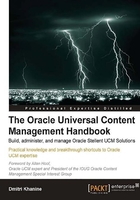
What are you going to learn?
There are two types of facts you'll be acquiring today. The basic concepts behind Oracle UCM, that unlock the rest of the knowledge for you, and additional stuff that your project at hand may urgently require.
Required information that you must internalize
No matter what you're planning on doing with Oracle UCM, you need to start with the Content Server. All major UCM modules, such as Document Management, Web Content Management, and Records Management are all based on it.
The best way to get started and understand the base Content Server paradigms is by reading the introduction in Chapter 1. Easily enough, it's called "Here's an easy way to understand the Content Server".
Note
If you're in a rush, don't install your local copy of Content Server at this point. Just flip through the pages and focus on introductions, summaries, headers, and illustrations.
Not sure what this sentence is trying to say! When you're learning at a maximum speed, you need to go for the "bird eye" view of all of the content.
Once you have a feel for how it works, take it a bit deeper and learn more about metadata and security. These are the two most important aspects of any Content Server implementation, and the one that you must understand in order to succeed.
I'm not asking you to carefully read and study the chapters at this point. You're after the "what" question, not the "how". Flip through the pages and see:
- What metadata is used for
- What's involved in creating a metadata model
- What are the basic concepts of Content Server Security
- How different security components fit together
At this point, you will find yourself a lot more comfortable and ready to focus on your specific UCM assignment.
Other stuff you might find useful
If you plan on doing some hands-on Content Server administration, review Chapter 2, Major Controls. This will get you instantly familiar with operations, diagnostics, and UCM troubleshooting, and show you how to manage users.
If you are planning on customizing Oracle UCM, skim Chapter 7 and Chapter 10. This will give you important insights about the inner workings of Content Server, its key file formats and all the tools, and choices you have for customizing its interface and behavior.
And if you are working or planning to work with a vendor then be sure to review the section called Five ways to maximize results and avoid disaster when working with a UCM vendor in Chapter 10. These street-tough project success tips will help you reduce your risk and avoid severe penalties to your budget, timeline, and your system functionality.
And last, but not least, I urge you to scan through Appendix A and get yourself familiar with the entire Oracle UCM product line up. Not only you will see how other modules integrate with Content Server, you will see what other tools and integration options you have at your disposal.
That's it. How did you do? Still have a bit of time left of your eight hours? Then how about some activity? Why not have a little fun with actually installing your own local copy of the Content Server? Or you can simply skim Chapter 1 and see what it takes to install.